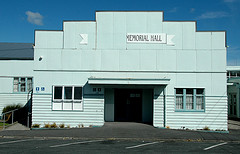An illustrated diary kept by a deer hunter during 1939 and 1940 lies at the heart of an exciting new biography published later this month by Craig Potton Publishing . Neville ‘Stag’ Spooner grew up in the Wairarapa during the Great Depression. His father was an enthusiastic carver, musician and hunter who taught his whole family to shoot and also encouraged their artistic abilities.
Stag started keeping records of his daily life as a child and continued the practice during his military service in World War II, until his early death in Fiordland aged just 28. It was the illustrated diary that he kept while working as a deer culler for the Department of Internal Affairs, first in the Tararuas and then on the West Coast of the South Island, that is being reproduced for the first time as part of this new book.
 |
| Neville 'Stag" Spooner |
“It’s the kind of exciting discovery of a Kiwi classic that everyone dreams about,” says Wellington based biographer Chris Maclean. “When I was first shown a copy of the original diary I was fascinated, it seemed a really significant find to me. I started out writing an explanatory essay to accompany the publication of the diary. But as I spoke with more of the family, my understanding of Stag’s creative output increased and so did the scope of the project.”
Stag Spooner: Wild man from the bush – The story of a New Zealand hunter – artist by Chris Maclean will be launched in Masterton on Saturday 28 August.

About the author
Chris Maclean is a Wellington historian, writer, photographer and publisher, with a keen interest in the outdoors. He has written a number of acclaimed and award-winning books, including Tararua , Waikanae, Kapiti, Wellington – Telling Tales, and a biography of John Pascoe. Chris is the great-grandson of George Whitcombe, founder of Whitcombe & Tombs.
'Stag' Spooner's diary a blend of art and history
From Wairapapa News 25/07/2012
http://www.stuff.co.nz/dominion-post/news/local-papers/wairarapa-news/entertainment/7343002/Stag-Spooners-diary-a-blend-of-art-and-history

With his shaggy dark hair and beard, and a discernible twinkle in his eye, there is something very contemporary- looking about the young man in the photo.
You could easily picture him strolling along Cuba St with all the other quirky 'Generation Y-ers'. But this photo was taken in 1939 and it shows Neville 'Stag' Spooner: passionate hunter, government deer culler, artist and diarist who grew up in Carterton, and later served in North Africa in World War II.
His remarkable story is told in a book, Stag Spooner: Wild Man from the Bush, and an accompanying exhibition being launched at Aratoi this weekend.

Neville (who earned his nickname of 'Stag' by his prowess for hunting) wrote that he was 'an artist by 7' and was well in the habit of recording his adventures by the time he was a teenager. For the Spooner family (five boys and one girl), these adventures typically involved hunting or fishing. Stag shot his first Tararua deer in 1935, aged 18, and by 1937 he had become a highly proficient hunter.
So the job of deer culler must have been a logical and attractive option, and this is the period in his life that he records in his 80-page visual diary (dated 1939-40), which he titled Those Wild Men from the Bush.
The diary shows the daily tasks involved in the life of a culler, employed to stem the decimating effects of a wildly proliferating deer population in the hinterlands. This was certainly a busy season, seeing Stag top the Westland cullers' tally, killing 525 deer in six months, including 41 in a day. He shows the various tasks involved, from hacking through the bush to make trails, tracking and shooting deer, skinning them and cutting off the tails to take back as proof. He also shows camp life at the end of a hard day, trips into town to see sweethearts, and the haircuts to make this 'Wild Man of the Bush' halfway presentable.

Aratoi director Marcus Boroughs describes the diary, passed down through the Spooner family since Stag's untimely death, as having a local focus but a national significance. 'It's like a real life Boys Own Annual . . . a fabulous blending of art and history. For a young man of that era to be out in the Tararuas not only hunting and shooting but also recording his experiences in artwork is really extraordinary.'
Ironically, the renowned sharp shooter served in a non- combat role in a Field Ambulance Unit for the duration of the war. Here, he continued writing and drawing but this time mainly in the form of decorated envelopes sent home to his family. These show his developing confidence and skill as an artist, often blending military scenes with Tararua hunting imagery, and also his keen sense of humour. They caught the attention of his colleagues and led to a side business selling selected envelopes.
Stag, along with his brothers Tory and Bryan, survived the war but he died tragically on a solo hunting expedition near Lake Te Anau, aged 28. The exhibition, which also includes a large range of trophy deer heads, carvings by Stag and other objects, begs the question as to what this talented young man would have accomplished.
Stag Spooner - Those Wild Men from the Bush, July 27 to September 30; Face Value - Portraits from the Collection, until November 4; Stephen Duncan, until July 28; Foyer Exhibits - Selected works from The Rutherford Collection & Kajsa Bckstrm.
- Wairarapa News 25/07/2012

























